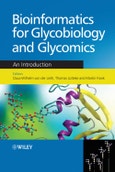The availability of comprehensive databases and corresponding bioinformatics tools, to access and analyse the large amounts of experimental data relating to the structure of carbohydrates, will be a prerequisite for the success of the large-scale glycomics projects that aim to decipher new, so far unknown, biological functions of glycans. Efficient bioinformatics descriptions and tools can considerably enhance the efficiency of glycomics research, in terms of data quality, analysis and experimental costs.
For a complete understanding of the molecular processes in which carbohydrates are involved, such as protein–carbohydrate interactions and the impact of glycosylation on protein function, knowledge of the 3D structure of the carbohydrate, the protein–carbohydrate complex, or the glycoprotein is often indispensable. This book provides a thorough introduction into methods used for conformational analysis of carbohydrates.
Key features:
- Describes bioinformatic approaches to handle carbohydrate-active enzymes and glycosylation.
- Provides an overview on bioinformatics tools that facilitate analysis of carbohydrate structures.
- Gives introduction into molecular modelling of carbohydrate 3D structure and carbohydrates contained in the Protein Databank.
- Assumes only a basic knowledge of biology and bioinformatics.
Table of Contents
List of Contributors.Preface (Claus-Wilhelm von der Lieth).
Section 1: Introduction.
1. Glycobiology, Glycomics and (Bio)Informatics (Claus-Wilhelm von der Lieth).
Section 2: Carbohydrate Structures.
2. Introduction to Carbohydrate Structure and Diversity (Stephan Herget, René Ranzinger, Robin Thomson, Martin Frank and Claus-Wilhelm von der Lieth).
3. Digital Representations of Oligo- and Polysaccharides (Stephan Herget and Claus-Wilhelm von der Lieth).
4. Evolutionary Considerations in Studying the Sialome: Sialic Acids and the Host–Pathogen Interface (Amanda L. Lewis and Ajit Varki).
Section 3: Carbohydrate-active Enzymes and Glycosylation.
5. Carbohydrate-active Enzymes Database: Principles and Classification of Glycosyltransferases (Pedro M. Coutinho, Corinne Rancurel, Mark Stam, Thomas Bernard, Francisco M. Couto, Etienne G. J. Danchin and Bernard Henrissat).
6. Other Databases Providing Glycoenzyme Data (Thomas L¨utteke and Claus-Wilhelm von der Lieth).
7. Bioinformatics Analysis of Glycan Structures from a Genomic Perspective (Kiyoko F. Aoki-Kinoshita and Minoru Kanehisa).
8. Glycosylation of Proteins (Claus-Wilhelm von der Lieth and Thomas Lüteke).
9. Prediction of Glycosylation Sites in Proteins (Karin Julenius, Morten B. Johansen, Yu Zhang, Søren Brunak and Ramneek Gupta).
Section 4: Experimental Methods – Bioinformatic Requirements.
10. Experimental Methods for the Analysis of Glycans and Their Bioinformatics Requirements (Claus-Wilhelm von der Lieth).
11. Analysis of N- and O-Glycans of Glycoproteins by HPLC Technology (Anthony H. Merry and Sviatlana A. Astrautsova).
12. Glycomic Mass Spectrometric Analysis and Data Interpretation Tools (Niclas G. Karlsson and Nicolle H. Packer).
13. Software Tools for Semi-automatic Interpretation of Mass Spectra of Glycans (Kai Maass and Alessio Ceroni).
14. Informatics Concepts to Decode Structure-Function Relationships of Glycosaminoglycans (Rahul Raman, S. Raguram and Ram Sasisekharan).
15. NMR Databases and Tools for Automatic Interpretation of Spectra of Carbohydrates (Claus-Wilhelm von der Lieth).
16. Automatic Spectrum Interpretation Based on Increment Rules: CASPER (Roland Stenutz).
17. Interpretation of 13C NMR Spectra by Artificial Neural Network Techniques (NeuroCarb) (Andreas Stoeckli, Matthias Studer, Brian Cutting and Beat Ernst).
Section 5: 3D Structures of Complex Carbohydrates.
18. Conformational Analysis of Carbohydrates – A Historical Overview (Martin Frank).
19. Predicting Carbohydrate 3D Structures Using Theoretical Methods (Martin Frank).
20. Synergy of Computational and Experimental Methods in Carbohydrate 3D Structure Determination and Validation (Thomas Lütteke and Martin Frank).
Section 6: Protein–Carbohydrate Interaction.
21. Structural Features of Lectins and Their Binding Sites (Remy Loris).
22. Statistical Analysis of Protein–Carbohydrate Complexes Contained in the PDB (Thomas Lütteke and Claus-Wilhelm von der Lieth).
Section 7: Appendices.
Appendix 1: List of Available Websites.
Appendix 2: Glossary.
Index.
Samples

LOADING...








